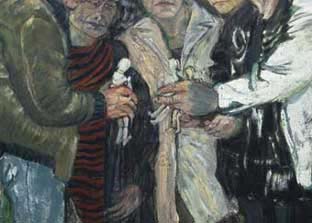Gustav Kluge Teamportrait Moabit Click for English text Mit der Ausstellung "Teamportrait Moabit" zeigt Wohnmaschine erstmals Arbeiten des Hamburger Malers Gustav Kluge (* 1947) und präsentiert einen Künstler, der sich in seinem malerischen Werk immer wieder kritisch mit politischen Themen auseinandersetzt. Kluges künstlerische Position vor dem Hintergrund der Debatte um die aktuelle deutsche Malerei zu betrachten, war Ausgangspunkt für die Zusammenarbeit zwischen dem Künstler und Wohnmaschine. Das Gemälde "Teamportrait Moabit" in dessen Zentrum ein Gruppenporträt der Mitarbeiter des bzfo - Behandlung-szentrum für Folteropfer Berlin zu sehen ist, entstand über den Zeitraum eines Jahres hinweg. Ergänzt wird die Arbeit durch eine Installation mit einer Pilotenuniform und Dokumentationsmaterialien: Publikationen des Behandlungszentrums, Artikel zum Thema Folter aus dem Archiv des bzfo, Jahrgänge der Zeitschrift "Psyche" sowie die zur Ausstellung erscheinende Publikation. Nach früheren Arbeiten zum Themenkomplex Folter und Gewalt wie "Wiedereinführung der strengen Befragung" von 1984 und einem Gruppenportrait von drei Überlebenden des KZ Neuengamme von 1995, dokumentiert Kluge mit dem Gemälde "Teamportrait Moabit" die Arbeit der Mitarbeiter des Behandlungszentrums für Folteropfer während einer supervisionsähnlichen Sitzung. "Als ich das Bild malte, stand ich vor dem Problem, wie ich den polizeilich-militärischen Komplex, der oft in den Terror der Folter involviert ist, zur Sprache bringen kann. Die Uniform ist kein Symbol, sie hat den Status des Indizes. Ohne den polizeilich-militärischen Komplex ist Folter nicht organisierbar (…). Für mich ist das Bild eine Allegorie, die die dargestellte Gruppe von Therapeuten und zugleich den gesellschaftlichen Raum meint, in dem wir heute leben. Die drei Bild-Elemente - Gletscher, Trichter-Kegel-Konstruktion, Pilotenuniform - vernetzen sich mit Gedankensträngen, die aus dem Bild hinausweisen. (…) Der aufgeschnittene und der ihn aufnehmende Kegel (…) repräsentieren das rationale Funktionieren der Folter-Systeme, die in das jeweilige politische Kalkül hineingebaut sind" (Gustav Kluge im Interview mit Marius Babias). Mit den in der Ausstellung zugänglichen Informationen aus der Bibliothek des bzfo wird eine weitere wichtige Funktion des Behandlungszentrums für Folteropfer hervorgehoben: die Möglichkeit, Belege über politische Gewalt, Folter und Folterstaaten der Öffentlichkeit zugänglich zu machen, Akteure zu benennen und den Deckmantel des Schweigens zu durchbrechen. Die Dokumentation und das Bild stehen sich damit im Ausstellungsraum gleichwertig gegenüber. Zur Ausstellung erscheint eine umfangreiche Publikation: Gustav Kluge: "Teamportrait, Moabit". Kerber Verlag, 2005 mit Beiträgen von Sepp Graessner zu institutionellen und politischen Hintergründen der Arbeit mit Folteropfern, von Sylvia Karcher zur therapeutischen Arbeit sowie einem Interview von Marius Babias mit Gustav Kluge. Ausstellungsdauer: 15.4. - 21.5.2005 Oeffnungszeiten: Di-Sa 11 - 18 Uhr WOHNMASCHINE Friedrich Loock Tucholskystrasse 35 D-10117 Berlin Telefon +49 30 3087 2015 Fax +49 30 3087 2016 Email info@wohnmaschine.com www.wohnmaschine.com Gustav Kluge Teamportrait Moabit With the exhibition "Teamportrait Moabit" (Team Portrait Moabit), Wohnmaschine is showing for the first time works by the Hamburg painter Gustav Kluge (born in 1947), presenting an artist who in his paintings again and again has engaged critically with political issues. The starting point for this collaboration between the artist and Wohnmaschine was to explore Kluge's artistic position before the backdrop of the debate on current German painting. The painting Teamportrait Moabit at its center is a group portrait of employees at bzfo, Behandlungszentrum für Folteropfer Berlin (Berlin Center for the Treatment of Torture Victims), that emerged over a period of one year. The work is complemented by an installation with a pilot uniform and documentary materials: publications from the bzfo, articles on the issue of torture from the archive of the bzfo, a numbers of volumes of the journal "Psyche", as well as the publication appearing to mark the exhibition. After earlier works on the complex of issues around torture and violence like the 1984 work "Wiedereinführung der strengen Befragung" (Reintroduction of Severe Interrogation Methods) from 1984 and a group portrait of three survivors from the concentration camp Neuengamme from 1995, Kluge documents in the painting "Teamportrait Moabit" the work of the Center for the Treatment of Torture Victims during a staff meeting. "When I was painting the picture, I was faced with the problem of how to bring up the police-military complex which is often involved in the terror of torture. The uniform isn't a symbol - it merely provides evidence. There is no way to organize torture without the police-military complex (…). For me, the picture is an allegory representing both the portrayed group of therapists and the social space in which we live. These three pictorial elments - glacier, funnel-cone construction, pilot uniform - interweave with strings of thought which stretch out of the picture. (…) The dissected cone being pulled into the lower cone (…) represent the rational function of torture systems built into any political calculation" (Interview Marius Babias with Gustav Kluge). With the information from the library of the bzfo available in the exhibition, an additional important function of the center is brought into focus: the possibility of making public the facts on political violence, torture, and the states that use torture, naming the actors and lifting the blanket of silence. The documentary material and the painting thus stand equal in the exhibition space. The exhibition will be accompanied by an extensive publication, "Gustav Kluge: Teamportrait, Moabit", published by Kerber Verlag, 2005, with contributions by Sepp Graessner on the institutional and political backdrop of working with victims of torture, Sylvia Karcher on therapeutic work, as well as an interview by Marius Babias with Gustav Kluge. Exhibition: April 15 - May 21, 2005 Opening hours: Tues-Sat 11 am - 6 pm |
|
